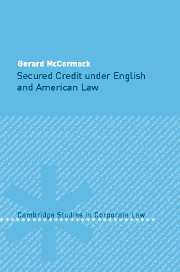Book contents
- Frontmatter
- Contents
- Preface
- List of abbreviations
- 1 The essence and importance of security
- 2 Security rights under English law
- 3 An overview of Article 9 of the Uniform Commercial Code
- 4 Implications of Article 9-type reforms for the English law of security interests
- 5 Notice filing versus transaction filing
- 6 Retention-of-title clauses under English law and Article 9
- 7 Receivables financing
- 8 Security interests in deposit accounts, investment property and insurance policies
- Appendix: Article 9 of the Uniform Commercial Code
- Index
3 - An overview of Article 9 of the Uniform Commercial Code
Published online by Cambridge University Press: 23 July 2009
- Frontmatter
- Contents
- Preface
- List of abbreviations
- 1 The essence and importance of security
- 2 Security rights under English law
- 3 An overview of Article 9 of the Uniform Commercial Code
- 4 Implications of Article 9-type reforms for the English law of security interests
- 5 Notice filing versus transaction filing
- 6 Retention-of-title clauses under English law and Article 9
- 7 Receivables financing
- 8 Security interests in deposit accounts, investment property and insurance policies
- Appendix: Article 9 of the Uniform Commercial Code
- Index
Summary
This chapter looks at the basic features of Article 9 of the Uniform Commercial Code and compares it with the English law pertaining to security interests in personal property. According to received wisdom, it is a fundamental part of a modern system of secured-transactions law that public notice of the existence of a security interest in property must be given. For example, in the EBRD Principles of Secured Transactions Law it is stated that the existence of a security right over property must be effectively publicised. Public notice and consequential registration requirements are a central feature of Article 9 of the UCC and also of the English system. It is fair to say, however, that the registration obligation under Article 9 is much more extensive and overarching. Moreover, Article 9 contains more superficially straightforward rules for determining priorities between competing security interests in the same collateral. English law is often compared unflatteringly in this respect with the position in the United States.
The general features of Article 9
The fundamental features of Article 9 and other systems modelled upon it such as those in the common-law provinces of Canada and now in New Zealand are firstly, a bias in favour of functionalism rather then formalism and secondly, a registration obligation that is very extensive in its ambit. In other words, there is a general principle enshrined in the law that public notice of the security interest must be given.
- Type
- Chapter
- Information
- Secured Credit under English and American Law , pp. 70 - 98Publisher: Cambridge University PressPrint publication year: 2004



